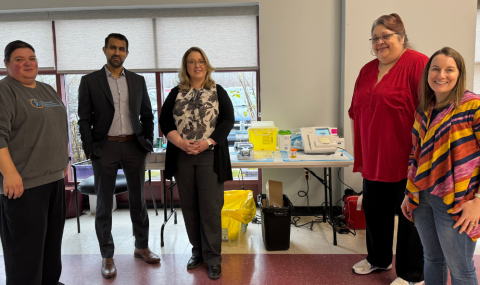Oxygen therapy
- The normal percentage of oxygen in the air is 21%. If a person needs a higher percent of oxygen, it is considered a medical therapy. Many patients are given between 30 – 50% oxygen.
- Extra oxygen can be given using nasal prongs, a mask over the nose and mouth, or by ventilator support with a tube into the lungs. Some masks use pressure to ensure the oxygen gets into the lungs. This is called BiPAP (Bi-level Positive Airway Pressure) or CPAP (Continuous Positive Airway Pressure). The pressure used at inhalation or exhalation helps prevent the lungs from collapsing all the way. If the person is on a ventilator, the positive pressure therapy is called PEEP (Positive End Expiratory Pressure).
Mechanical Ventilator
- A mechanical ventilator is a machine that breathes for the patient when they are not well enough to do so on their own. Helping a patient breathe is essential to life support. A tube can be placed into the lungs either through the mouth or through an artificial hole in the throat called a tracheostomy. This is called intubation.
- The ventilator is used to support a patient who cannot breathe effectively on their own. As the patient starts to recover, the type of support offered by the machine can change so the patient can breathe more on his or her own.
Tracheostomy
- A tracheostomy is a hole made into the throat just below the Adam’s apple and into the windpipe (trachea). The team will also consider making a tracheostomy if a patient has to be on a ventilator for a longer period of time. Ventilation with a tube through the mouth can become dry and uncomfortable. and could potentially damage the vocal cords if left in for a long period of time.
- If a person no longer needs ventilator support, the tracheostomy can be easily removed. Once removed, the site of the tracheostomy will heal fairly quickly and usually leave a small scar.
Chest Tubes and Drains
- If there is a lot of fluid or air around the lungs, it can become difficult or impossible for the lungs to expand and deliver oxygen to the blood. The lungs are surrounded by the pleural membrane. This barrier helps keep the pressure higher in the lungs than in the space around it, preventing the parts of the lungs that exchange gases from collapsing. A person can end up with fluid or air around the lungs for a number of reasons, such as surgery in the chest, injury, or fluid imbalances in the body.
- One way to deal with fluid or air around the lungs is to insert a special drainage tube (chest tube) to remove the air or fluid, allowing the lung to re-expand.
Chest Physiotherapy
- Critical illness and periods of inactivity can cause fluid (secretions) to build up in the lungs, making it harder to breathe. The physiotherapist or nurse can help patients to move the secretions out of their lungs by tapping over the areas that are filling up and helping them cough.
Suctioning
- Suctioning is necessary to help clear a patient’s airway if they are unconscious or unable to cough effectively. Suctioning basically vacuums out any secretions (fluid, mucous). A nurse, respiratory therapist, or physiotherapist will insert the suction tube (catheter) and remove it right away. The suctioning is turned on while it is being removed from the airway.
Positioning
- The head of the bed should be kept between 30 and 45 degrees. This reduces the amount of work needed to breathe and reduces the risk of breathing fluid into the lungs if a person has secretions. It also reduces the chance of lung infection. Staff will change a patient’s position every couple of hours if it is safe to do so.
Endotracheal tube
- An endotracheal tube is a tube inserted through the mouth down into the lungs; it is used to deliver oxygen with a ventilator directly into the lungs. The procedure of placing the tube into the lungs is called intubation.


